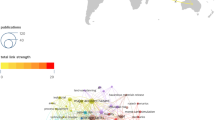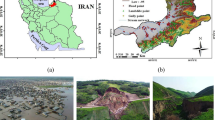Abstract
Today, many natural disasters occur in the world. Damage caused during disaster assessment has been a vital process. Traditional methods of assessing the cause of damage are neither fast nor efficient. In disaster error estimation, progress has been made in recent years. Internet resources serve as a dynamic facilitator to obtain data for the model and produce the desired output. The proposed hybrid CNN helps in detecting and identifying the natural disaster damage and also precisely assesses the damages with higher accuracy. Hybrid CNN performance metrics, such as accuracy, precision, recall, and F1 score, are compared with logistic regression, support vector machine, gradient boosting, and random forest algorithms in the processing of imagery data with natural disaster regions and provide the cost estimation with any objects precisely over the higher accuracy rate of greater than 96%.










Similar content being viewed by others
Explore related subjects
Discover the latest articles and news from researchers in related subjects, suggested using machine learning.Data availability
No datasets were generated or analysed during the current study.
References
AlAli ZT, Alabady SA (2022) A survey of disaster management and SAR operations using sensors and supporting techniques. Int J Disaster Risk Reduct 82:103295. https://doi.org/10.1016/j.ijdrr.2022.103295
Alam F, Alam T, Hasan MA et al (2023) Neural Comput Applic 35:2609–2632. https://doi.org/10.1007/s00521-022-07717-0. MEDIC: a multi-task learning dataset for disaster image classification
Boppana V, Ramabrahmam G, Swaminathan (2000) Disaster management plan for chemical process industries. Case study: investigation of release of chlorine to atmosphere. J Loss Prev Process Ind 13(1):57–62. https://doi.org/10.1016/S0950-4230(98)00057-6
Cardona OD, Ordaz MG, Yamin LE, Marulanda MC, Barbat AH (2008) Earthquake loss Assessment for Integrated Disaster Risk Management. J Earthquake Eng 12(sup2):48–59. https://doi.org/10.1080/13632460802013495
Chandana SA, Siriwardana GP, Jayasiri SSL, Hettiarachchi (2018) Investigation of efficiency and effectiveness of the existing disaster management frameworks in Sri Lanka. Procedia Eng 212:1091–1098. https://doi.org/10.1016/j.proeng.2018.01.141
Cheng Z, Liu J, Sun J (2017) Machine learning for disaster management: a survey. Nat Hazards Earth Syst Sci 17(5):723–737. https://doi.org/10.5194/nhess-17-723-2017
Comprehensive Disaster Management Programme (CDMP-II) Ministry of Disaster management and Relief (2012). Report on the Landslide Hazard Zonation mapping at Cox’s Bazaar and Teknaf in Bangladesh
Coppola D (2006) Introduction to international disaster management. Elsevier
Crosweller M (2022) Demonstrates the disaster management leaders in Australia, New Zealand & USA when they are mindfulness practice affords leaders 16. https://doi.org/10.1016/j.pdisas.2022.100248
De Boer J, Debacker M (2006) Quantifying medical disaster management. Int J Disaster Med 4(3):98–102. https://doi.org/10.1080/15031430600975569
Dominey-Howes D (2002) Documentary and Geological Records of Tsunamis in the Aegean Sea Region of Greece and their potential value to Risk Assessment and Disaster Management. Nat Hazards 25:195–224. https://doi.org/10.1023/A:1014808804611
Dransch D, Poser K, Fohringer J, Lucas C (2014) Volunteered Geographic Information for Disaster Management. In I. Management Association (Ed.), Crisis Management: Concepts, Methodologies, Tools, and Applications. IGI Global pp. 477–496. https://doi.org/10.4018/978-1-4666-4707-7.ch021
Dressler G, Müller B, Frank K, Kuhlicke C (2016) Towards thresholds of disaster management performance under demographic change: exploring functional relationships using agent-based modelling. Nat Hazards Earth Syst Sci 16:2287–2301. https://doi.org/10.5194/nhess-16-2287-2016
Ehsan Shakeri B, Vizvari R Nazerian (2021) Comparative analysis of disaster management between India and Nigeria. Int J Disaster Risk Reduct 63. https://doi.org/10.1016/j.ijdrr.2021.102448
Eriksson Oskar and Gustafsson Matilda (2007) Disaster Management Capacity from a National Perspective. Brandteknik och Riskhantering
Fan C, Mostafavi A (2020) Metanetwork Framework for Performance Analysis of Disaster Management System-of-Systems. IEEE Syst J 14(1):1265–1276. https://doi.org/10.1109/JSYST.2019.2926375
US Fire Administration Wildland urban interface: a look at issues and resolutions. US Department of Homeland Security. https://www.usfa.fema.gov/stories/wui-report/index.html
Flanagan BE, Edward W, Gregory EJ, Hallisey JL, Heitgerd, Lewis B (2011) A Social Vulnerability Index for Disaster Management. J Homel Secur Emerg Manage. https://doi.org/10.2202/1547-7355.1792
Gaikwad B, Wanjari YW, Kale KV (2014) Disaster management by integration of web services with geospatial data mining. 2014 Annual IEEE India Conference (INDICON), Pune, India 1–6. https://doi.org/10.1109/INDICON.2014.7030685
Geddam SM, Raj Kiran CA (2024) Enhancing disaster management effectiveness: an integrated analysis of key factors and practical strategies through structural equation modeling (SEM) and scopus data text mining. Geohazard Mech. https://doi.org/10.1016/j.ghm.2024.03.001
Giusti A, Cireşan DC, Masci J et al (2013) Fast Image Scanning with Deep Max-Pooling Convolutional Neural Networks. arXiv
Gu J, Wang Z, Kuen J et al (2018) Recent advances in convolutional neural networks. Pattern Recogn 77:354–377
Ha KM (2023) Improving disaster management in international tourism. Manage Rev Q. https://doi.org/10.1007/s11301-023-00338-4
IPCC (2021) Climate Change 2021: the physical science basis. Contribution of Working Group I to the Sixth Assessment Report of the Intergovernmental Panel on Climate Change. Cambridge University Press. https://www.ipcc.ch/report/ar6/wg1/
Kaggle Dataset (nd) https://www.kaggle.com/datasets?tags=7407-Natural+Disasters
Kim J et al (2023) Safety map: disaster management road network for urban resilience. Sustain Cities Soc 96:104650. https://doi.org/10.1016/j.scs.2023.104650
Levi L, Bregman D, Geva H, Revach M (1998) Hospital Disaster Management Simulation System. Prehosp Disaster Med 8(131):22–27. https://doi.org/10.1017/S1049023X00032994
Li J, Wang Q (2019) The role of Machine Learning in Disaster Prediction and Management: an overview. Disasters 43(3):502–520. https://doi.org/10.1111/disa.12343
Li R, Di Y, Tian H (2024) Computer-aided resilience: Advanced techniques for disaster management in smart urban environments. Sustainable Cities Soc 108:2210–6707. https://doi.org/10.1016/j.scs.2024.105437
Ma Z, Li L, Hemphill L, Baecher GB, Yubai Yuan (2024) Investigating disaster response for resilient communities through social media data and the susceptible-infected-recovered (SIR) model: a case study of 2020 western U.S. wildfire season. Sustainable Cities Soc 106:2210–6707. https://doi.org/10.1016/j.scs.2024.105362
Madria S (2019) A Deep Learning Approach for Tweet Classification and Rescue Scheduling for Effective Disaster Management. In Proceedings of the 27th ACM SIGSPATIAL International Conference on Advances in Geographic Information Systems (SIGSPATIAL ‘19). Association for Computing Machinery, New York, NY, USA, 269–278. https://doi.org/10.1145/3347146.3359097
Marsella S, Pozzi S, Marzoli M (2019) Evacuation Planning as a Key Factor in Disaster Management: the contribution of the H2020 IN-PREP Action. Proceedings of the 10th International Multi-Conference on Complexity, Informatics and Cybernetics (IMCIC 2019)
Meshkini A, Bozorgvar A, Alipour S (2024) Spatial analysis of the physical resilience of old urban neighborhoods against earthquakes: a case study of the old texture of Tehran. GeoJournal 89(118). https://doi.org/10.1007/s10708-024-11101-x
NASA Earth Data, open access for open science (nd) https://www.earthdata.nasa.gov/learn/pathfinders/disasters
Ngcamu BS (2023) Application of the disaster management cycle and climate change: Studying flood disasters in South Africa. Social Sci Humanit Open 8(1):100657. https://doi.org/10.1016/j.ssaho.2023.100657
Pandey P, Litoriya R (2020) Elderly care through unusual behavior detection: a disaster management approach using IoT and intelligence. IBM J Res Dev 64(1/2):15:1–1511. https://doi.org/10.1147/JRD.2019.2947018
UN Office for Disaster Risk Reduction (2022) Global assessment report on disaster risk reduction: our world at risk: transforming governance for a resilient future. United Nations office of disaster risk reduction (UNDRR). https://www.undrr.org/media/79595/download?startDownload=true
Othman SH, Beydoun G (2010) A Disaster Management Metamodel (DMM) validated. In: Kang BH, Richards D (eds) Knowledge Management and Acquisition for Smart Systems and services. PKAW 2010. Lecture notes in Computer Science 6232. Springer, Berlin, Heidelberg. https://doi.org/10.1007/978-3-642-15037-1_11
Rajabifard A, Kalantari M (2020) Big Data for Disaster Management: opportunities and challenges. Int J Disaster Risk Reduct 48:101595. https://doi.org/10.1016/j.ijdrr.2020.101595
Razip AM, Malik A, Afzal S, Potrawski M, Maciejewski R, Jang Y, Elmqvist N, Ebert DS (2014) A mobile visual analytics approach for law enforcement situation awareness. IEEE Pac vis Symp 2014:169–176
Redmon J, Divvala S, Girshick R, Farhadi A (2016) You only look once: unified, real-time object detection. In: Proceedings of the IEEE conference on computer vision and pattern recognition. CVPR ’16. IEEE pp 779–788
Rodríguez JT, Vitoriano J (2012) Montero a general methodology for data-based rule building and its application to natural disaster management. Comput Oper Res 39(4):863–867. https://doi.org/10.1016/j.cor.2009.11.014
Rosyidi SA, Lin CCJ, Chik Z, Taha MR, Ismail A (2008) Development of Earthquake Disaster Management System in Bantul: Preliminary Study on Infrastructures Damages. The 14th World Conference on Earthquake Engineering, Beijing, China. https://www.iitk.ac.in/nicee/wcee/article/14_01-1022.pdf
Ruder S (2017) An overview of multi-task learning in deep neural networks. arXiv Preprint arXiv:1706.05098
Sasangohar F, Moats J, Mehta R, Peres SC (2020) Disaster ergonomics: human factors in COVID-19 pandemic emergency management. Hum Factors 62(7):1061–1068
Shah I, Elahi N, Alam A, Dawar S, Dogar AA (2020) Institutional arrangement for disaster risk management: Evidence from Pakistan. Int J Disaster Risk Reduct 51:101784. https://doi.org/10.1016/j.ijdrr.2020.101784
Shorten C, Khoshgoftaar TM (2019) A survey on image data augmentation for deep learning. J Big Data 6:1–48
Shukla D, Azad HK, Abhishek K (2023) Disaster management ontology- an ontological approach to disaster management automation. Sci Rep 13. https://doi.org/10.1038/s41598-023-34874-6
Smith W, Dowell J (2000) A case study of co-ordinative decision-making in disaster management. Ergonomics 43(8):1153–1166. https://doi.org/10.1080/00140130050084923
Son C (2023) Disaster Ergonomics: a human factors approach to address escalating challenges from disasters. Cogn Tech Work 25:325–344. https://doi.org/10.1007/s10111-023-00736-4
Strezoski G, van Noord N, Worring M (2019) Learning task relatedness in multi-task learning for images in context. In: Proceedings of the 2019 on International conference on multimedia retrieval. pp 78–86
Superio DL, Abaday EM, Mary Grace H, Oliveros, Allana S, Delgado, Vince Ervin V, Palcullo, Joy F, Geromiano (2019) Fire + water + bombs: disaster management among academic libraries in Marawi City, Lanao Del Sur, Philippines. Int J Disaster Risk Reduct 41. https://doi.org/10.1016/j.ijdrr.2019.101311
Sweta LO, Bijker W (2013) Methodology for assessing the usability of earth observation-based data for disaster management. Nat Hazards 65:167–199. https://doi.org/10.1007/s11069-012-0351-x
Taborri J, Pasinetti S, Cardinali L, Perroni F, Rossi S (2021) Preventing and monitoring work-related diseases in firefighters: a literature review on sensor-based systems and future perspectives in robotic devices. Int J Environ Res Public Health. https://doi.org/10.3390/ijerph18189723
Thomas A, Raja G (2019) A D2D based critical communications framework for disaster management in 5G. Peer-to-peer netw. Appl 12:912–923. https://doi.org/10.1007/s12083-018-0689-2
Thirukrishna JT, Krishna SRS, Shashank P et al (2022) Survey on Diagnosing CORONA VIRUS from radiography chest X-ray images using Convolutional neural networks. Wirel Pers Commun 124:2261–2270. https://doi.org/10.1007/s11277-022-09463-x
Thirukrishna JT et al (2023) Hybrid optimization enabled deep learning-based ensemble classification for heart disease detection. SIViP 17:4235–4244. https://doi.org/10.1007/s11760-023-02656-2
Turay B, Gbetuwa S (2022) A state-of-the-art examination of disaster management in Sierra Leone: the implementation drawbacks, research gaps, advances, and prospects. Geoenviron Disasters 9(22). https://doi.org/10.1186/s40677-022-00224-3
Vieweg S, Hughes AL, Starbird K, Palen L (2010) Microblogging during two natural hazards events: what twitter may contribute to situational awareness. 1079–1088. https://doi.org/10.1145/1753326.1753486
Wang Z, Ye X (2017) Social media analytics for natural disaster management. Int J Geogr Inf Sci 32(1):49–72. https://doi.org/10.1080/13658816.2017.1367003
Xing R, Ju W, Lu H (2024) A comprehensive evaluation model for forest fires based on MCDA and machine learning: a case study of Zhenjiang City, China. https://doi.org/10.1007/s10668-024-05125-z. Environ Dev Sustain
Yu X, Li C, Yen GG (2021) A knee-guided differential evolution algorithm for unmanned aerial vehicle path planning in disaster management. Appl Soft Comput 98. https://doi.org/10.1016/j.asoc.2020.106857
Acknowledgements
Not Applicable.
Funding
No funds, grants, or other support was received.
Author information
Authors and Affiliations
Contributions
J T Thirukrishna corresponding author responsible for -made substantial contributions to the conception or design of the work, or the acquisition, analysis, or interpretation of data, or the creation of new software used in the work, -drafted the work or revised it critically for important intellectual content, approved the version to be published; -agree to be accountable for all aspects of the work in ensuring that questions related to the accuracy or integrity of any part of the work are appropriately investigated and resolved.
Corresponding author
Ethics declarations
Competing interests
The authors declare no competing interests.
Generative AI and AI-assisted technologies in the writing process.
During the preparation no generative AI and AI-assisted content in the writing process used.
Additional information
Communicated by: H. Babaie.
Publisher’s note
Springer Nature remains neutral with regard to jurisdictional claims in published maps and institutional affiliations.
Rights and permissions
Springer Nature or its licensor (e.g. a society or other partner) holds exclusive rights to this article under a publishing agreement with the author(s) or other rightsholder(s); author self-archiving of the accepted manuscript version of this article is solely governed by the terms of such publishing agreement and applicable law.
About this article
Cite this article
J T, T. An enhanced discovery of multiple natural disasters using machine learning model. Earth Sci Inform 18, 324 (2025). https://doi.org/10.1007/s12145-025-01793-1
Received:
Accepted:
Published:
DOI: https://doi.org/10.1007/s12145-025-01793-1




